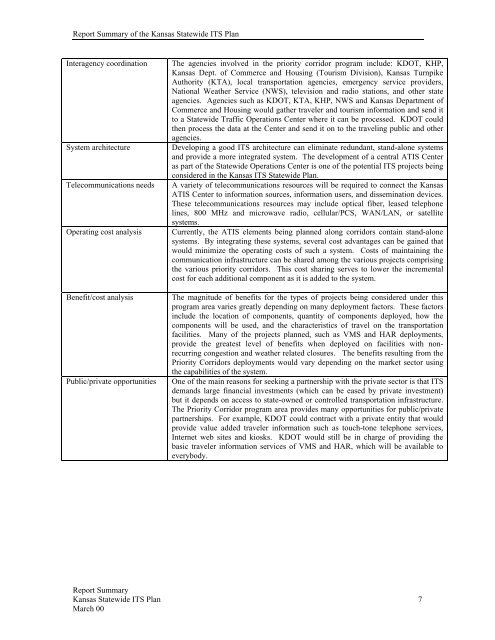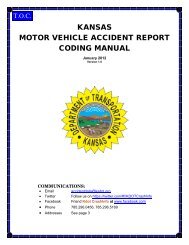Full Plan - Kansas Department of Transportation
Full Plan - Kansas Department of Transportation
Full Plan - Kansas Department of Transportation
You also want an ePaper? Increase the reach of your titles
YUMPU automatically turns print PDFs into web optimized ePapers that Google loves.
Report Summary <strong>of</strong> the <strong>Kansas</strong> Statewide ITS <strong>Plan</strong><br />
Interagency coordination<br />
System architecture<br />
Telecommunications needs<br />
Operating cost analysis<br />
Benefit/cost analysis<br />
Public/private opportunities<br />
The agencies involved in the priority corridor program include: KDOT, KHP,<br />
<strong>Kansas</strong> Dept. <strong>of</strong> Commerce and Housing (Tourism Division), <strong>Kansas</strong> Turnpike<br />
Authority (KTA), local transportation agencies, emergency service providers,<br />
National Weather Service (NWS), television and radio stations, and other state<br />
agencies. Agencies such as KDOT, KTA, KHP, NWS and <strong>Kansas</strong> <strong>Department</strong> <strong>of</strong><br />
Commerce and Housing would gather traveler and tourism information and send it<br />
to a Statewide Traffic Operations Center where it can be processed. KDOT could<br />
then process the data at the Center and send it on to the traveling public and other<br />
agencies.<br />
Developing a good ITS architecture can eliminate redundant, stand-alone systems<br />
and provide a more integrated system. The development <strong>of</strong> a central ATIS Center<br />
as part <strong>of</strong> the Statewide Operations Center is one <strong>of</strong> the potential ITS projects being<br />
considered in the <strong>Kansas</strong> ITS Statewide <strong>Plan</strong>.<br />
A variety <strong>of</strong> telecommunications resources will be required to connect the <strong>Kansas</strong><br />
ATIS Center to information sources, information users, and dissemination devices.<br />
These telecommunications resources may include optical fiber, leased telephone<br />
lines, 800 MHz and microwave radio, cellular/PCS, WAN/LAN, or satellite<br />
systems.<br />
Currently, the ATIS elements being planned along corridors contain stand-alone<br />
systems. By integrating these systems, several cost advantages can be gained that<br />
would minimize the operating costs <strong>of</strong> such a system. Costs <strong>of</strong> maintaining the<br />
communication infrastructure can be shared among the various projects comprising<br />
the various priority corridors. This cost sharing serves to lower the incremental<br />
cost for each additional component as it is added to the system.<br />
The magnitude <strong>of</strong> benefits for the types <strong>of</strong> projects being considered under this<br />
program area varies greatly depending on many deployment factors. These factors<br />
include the location <strong>of</strong> components, quantity <strong>of</strong> components deployed, how the<br />
components will be used, and the characteristics <strong>of</strong> travel on the transportation<br />
facilities. Many <strong>of</strong> the projects planned, such as VMS and HAR deployments,<br />
provide the greatest level <strong>of</strong> benefits when deployed on facilities with nonrecurring<br />
congestion and weather related closures. The benefits resulting from the<br />
Priority Corridors deployments would vary depending on the market sector using<br />
the capabilities <strong>of</strong> the system.<br />
One <strong>of</strong> the main reasons for seeking a partnership with the private sector is that ITS<br />
demands large financial investments (which can be eased by private investment)<br />
but it depends on access to state-owned or controlled transportation infrastructure.<br />
The Priority Corridor program area provides many opportunities for public/private<br />
partnerships. For example, KDOT could contract with a private entity that would<br />
provide value added traveler information such as touch-tone telephone services,<br />
Internet web sites and kiosks. KDOT would still be in charge <strong>of</strong> providing the<br />
basic traveler information services <strong>of</strong> VMS and HAR, which will be available to<br />
everybody.<br />
Report Summary<br />
<strong>Kansas</strong> Statewide ITS <strong>Plan</strong> 7<br />
March 00

















